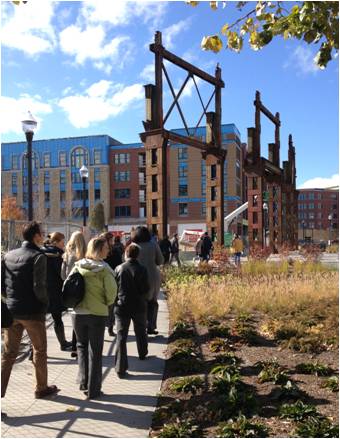The City of Somerville, close to Boston, is about to undergo the kind of land use transformation not likely to be seen again in decades, with the Green Line subway adding 6-7 new stations to Somerville neighborhoods and a new Orange Line station in Assembly Square. With this opportunity, comes the challenge of how to ensure that the benefits of all this development flow to all residents and embody the values the community cares about. This challenge has been met actively with a collaborative partnership approach among community organizations, residents, and other partners – ensuring that community values and equitable outcomes are integrated into these major new urban development and transportation infrastructure investments.
A Learning Journey to Somerville, MA
The story of how this was done was the focus of the Great Neighborhoods Network second “learning journey” on October 29, 2013, with a presentation, a trolley and walking tour of several sites, and then small group conversations on current challenges. The Great Neighborhoods is an initiative of the MA Smart Growth Alliance (MSGA) and provides support to strengthen place governance, a collaborative approach to the planning, development and maintenance of places. New Directions Collaborative worked with MSGA and multiple partners from Somerville’s initiative to plan and facilitate this site tour and network event, which sold out with 45 people attending.
Here are some of the highpoints of Somerville’s approach: 
- Somerville Community Corporation (SCC), Friends of the Community Path, Groundwork Somerville and the Somerville Transportation Equity Partnership (STEP) have been working as a coalition in partnership. Mashael Majid with SCC said “The coalition partners are earnestly dedicated to one another’s work. A lot of our direct investment lies in building relationships, both amongst ourselves and within the Somerville community. Because we have an overarching framework of equity we all believe in, we support our respective causes as means of a greater end– trying to make Somerville a more equitable city for all, but especially those who are most vulnerable to being displaced, underserved, and exposed to various hazards.” Another coalition member said “We communicate and reinforce each other’s work so it can be comprehensive.” For example, if there is an important hearing on an issue that one group has focused on, they will publicize it through their respective networks to get greater attendance.
- SCC developed messaging and a web site with the slogan: “Everyone’s Somerville” as a way to focus on a positive vision of making Somerville livable and accessible for people of all incomes and backgrounds. Over the past two years, they have engaged over 4,000 community residents in local activities and advocacy, including coordinating a successful campaign to pass the Community Preservation Act which will bring $1.5 million per year to Somerville for affordable housing, open space and community development. The ballot question won over 70% yes votes.
- A Community Corridor Planning initiative engaged more than 900 community members over the course of 5 years around the Green Line transit corridor. A series of community meetings helped to refine a set of 11 core principles for neighborhood development along the Green Line corridor, e.g., create local jobs, keep Somerville affordable, create community gathering spaces. SCC and Groundworks Somerville are working together to ensure new developments incorporate these principles, including a flagship project planned at 181 Washington St. Several community design meetings were held to ensure that this project is aligned with community values. It will be a multi-use building, a short walk from one of the new Green Line stops and will include 35 units of affordable housing, commercial space on the first floor and be designed with green building principles.
- The Somerville Transportation Equity Project (STEP) has a mission to secure transportation for the city that will increase social equity, environmental health, and economic opportunity. On the tour, we saw how the new development under construction at Assembly Square incorporated thse values and learned how citizens had changed the direction of the project from big box retail stores to multi-use housing and commercial space and open space along the Mystic River. STEP is doing leading edge research about the health impacts of transportation-related air pollution, which disproportionately affect “environmental justice” communities.
- The Friends of the Community Path is a citizen-led group that is working to build out two miles of a bike path through Somerville that will connect the Minute Man bikeway in Bedford/Arlington to the Charles River bikeway – the missing link will create a 48 mile connected trail through the Boston area. They held the vision for this and advocated with the City ofSomerville and Massachusetts Department of Transportation’s Green Line Extension (GLX) Design Team to get the bikeway included as the Green Line expansion was being designed. They created a design concept showing how the bike path could be incorporated into the design, a great example of advocates offering feasible solutions rather than solely asking for government to act or criticizing current approaches.
“The strength of smart growth, especially as it applies to our Great Neighborhoods work, is in bundling the package of issues into a single framework….Our call to action is to try to retell the story and find ways to make a compelling case for getting the conventional stakeholders on plan with a broader vision and/or finding new stakeholders who share this vision to invest in the transformation taking place in Somerville.” This is how a leader from Somerville summarized their approach in reflecting on what has worked as part of evaluation of the Great Neighborhoods Initiative. Andre Leroux of the MA Smart Growth Alliance said Somerville’s work is a great example of local and state policy and plans working off each other, with community groups engaging and mobilizing residents to create development that achieves multiple positive benefits for jobs, the environment, and all residents.
